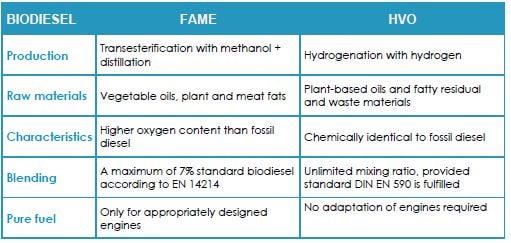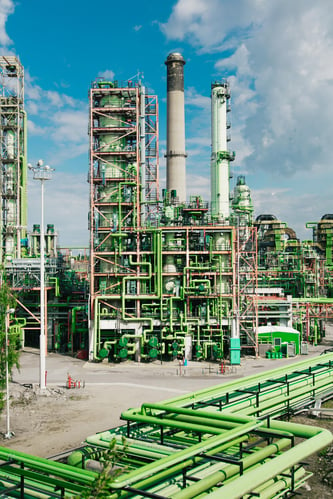Biodiesel as an important contribution to climate protection
Biodiesel emits between 65 and 90 % less CO2 than fossil diesel and reduces CO2 emissions by around 3 kg with each kilogram of biodiesel. The use of biodiesel thus makes an important contribution to climate protection in the transportation sector.
In addition, the use of waste and residual materials contributes to a sustainable circular economy and transforms waste into a competitive and low-emission form of transport energy.
Biodiesel accounts for the largest share of biofuel consumption in transportation. In 2020, this share was 73.8%.
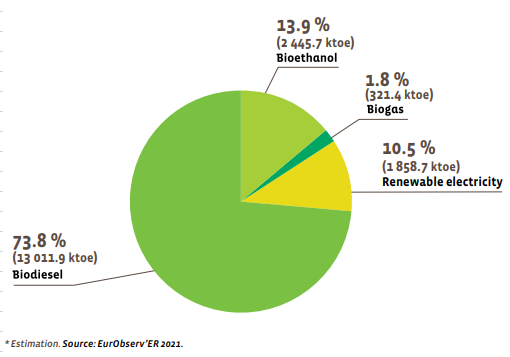
In total, biofuels were used in the EU at a rate of 15.8 million metric tons of which approximately 13 Mt were accounted for by biodiesel.
At almost 98%, road transport remains the most important consumption sector in the area of renewable energies, ahead of rail transport and other modes of transport.
With the decarbonization of the transport sector being pushed throughout Europe, biodiesel consumption is also on the rise. Companies that sell CO2-emitting fuels must compensate for the greenhouse gas emissions generated when these fuels are burned. Those who violate the quota pay high penalties for each additional ton of greenhouse emitted gas.
The GHG quota for companies subject to quotas, mostly mineral oil companies, is to be gradually increased to 25% by 2030 (currently 6% in Austria). Accordingly, the demand for biodiesel is increasing. Also in view of the insufficient expansion of production capacities for renewable electricity, biodiesel will take a leading role in replacing fossil fuels in the coming years in order to achieve the ambitious goals of climate change.
Comparison of FAME biodiesel and HVO biodiesel
Biodiesel can be used as a pure fuel or blend component in all modes of transport (road, air, sea and inland shipping transport). Road transport dominates in terms of volume, but there are growing opportunities for other applications as part of the EU's Fit for 55-Pakets .
Both FAME biodiesel (fatty acid methyl ester) and HVO biodiesel (hydrogenated vegetable oil) are approved for blending with fossil diesel. Both are produced from renewable feedstocks, including vegetable oils, used cooking oils (UCOs), animal fats, and biogenic waste and residual materials.
Although FAME and HVO use similar raw materials, the production processes and the properties of the biodiesel produced are different. This subsequently influences the blending options:
1. FAME-Biodiesel
FAME is produced by transesterification of fats or oils with methanol. The end product is similar to conventional diesel but has a higher oxygen content. FAME biodiesel is marketed as a pure fuel at service stations, but it is also blended with fossil diesel. The added biodiesel must meet the blending quality requirements of EN 14214. When produced from waste and residual materials, final purification through distillation is required.
In Europe, a maximum of 7% FAME is permitted in diesel fuel (B7). To reduce global CO2 emissions, this proportion is to be increased in the future according to current EU plans. Pure FAME biodiesel (B100) may only be used for suitably designed engines.
2. HVO-Biodiesel
HVO is developed by hydrogenating vegetable oils and fatty waste materials instead of methanol. Compared to FAME biodiesel, HVO is a hydrocarbon almost chemically identical to mineral diesel.
Since HVO biodiesel does not differ from fossil diesel, it can be used as a pure fuel without having to adjust the engine. Blending is possible in any mixing ratio as long as the diesel fuel standard DIN EN 590 is met. HVO is currently used as an admixture in aviation.
The shortage of biodiesel plants causes prices to explode
High raw material costs and the flooding of Europe with palm oil biodiesel at dumping prices have led to considerable price pressure in the European biodiesel market in recent years. As a result of this development, numerous biodiesel plants in Europe have closed their doors. In addition, price increases on the crude oil market and rising CO2 taxes exacerbate the market situation.
Oil companies, which have to meet their GHG reduction obligations, are now desperate to find biodiesel blended with other fuels. Given the increasing commitment to climate protection and more sustainable energy use, demand and price levels are likely to remain high in the future.
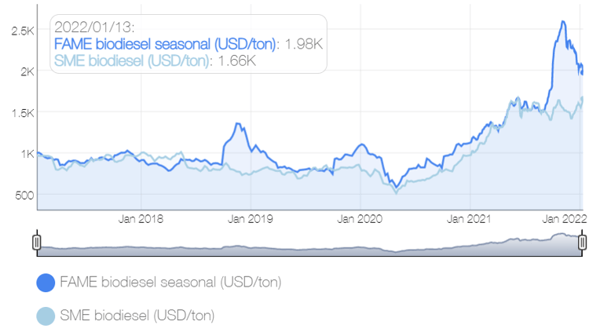
Source: Neste
First-generation biodiesel loses market opportunities
Among other things, biodiesel is regulated according to the type of feedstock used and is divided into different categories. The classification determines whether crediting is permitted in calculating the national share for renewable energies. In addition, a distinction is made between "conventional" and "advanced" biodiesel, also called first-generation and second- or third-generation biodiesel.
- Conventional biodiesel: First-generation biodiesel is produced based on raw materials that serve as food and animal feed. These include vegetable oils that can also be used as food.
- Advanced biodiesel: Second-generation advanced biodiesel uses animal and plant waste and residues that do not compete directly with food and feed crops. Third-generation biodiesel is produced through microbial production and does not compete with food production. Microalgae, bacteria, fungi, and yeasts are used as raw materials. Intensive research is still underway in this area.
The paradigm shift in EU energy policy
Europe has set a target to reduce greenhouse gas emissions by 55% by 2030 compared to 1990 levels. To achieve this goal, several updates to energy legislation are currently underway. At the core of these updates is the Renewable Energy Directive (RED II) amendment as part of the "Fit for 55" package.
The directive revision promotes investments in existing or new renewable energy technologies. To reach this goal, the overall target for renewable energies is set to be increased from 32% to 40%.
Emissions-based benchmark in the transport sector
For the transport sector, the introduction of a GHG reduction target of 13% based on a new emissions-based benchmark is planned. The reduction target by 2030 corresponds to an energy-based target of 28% using the methodology in the current directive (RED II).
An additional secondary target is provided for advanced biofuels at the rate of 2.2% by 2030 (simply counted). Biofuels produced from feedstocks listed in Annex IX-A and B of the Directive may no longer be dually counted when meeting national targets.
Therefore, the new regulation leads to a significant increase of requirements in the transport sector, compared to the current target of 14% for transport (energy-based) and a sub-target of 3.5% for advanced biofuels (double-counted).
Neste Oil is the leader in the world HVO market with its state-of-the-art facilities
© NESTE, Porovo, Finland.
Promotion of advanced biofuels
Shifting the focus from the pure share of renewable energies to CO2 neutrality means gradually abandoning biodiesel from cultivated biomass instead of using advanced biodiesel from greenhouse gas-efficient feedstocks. Consequently, the market opportunities for second-and third-generation biodiesel are increasing. However, it will be harder for first-generation biodiesel, with its strict blending regulations, to compete in the future.
Biodiesel plants: Which ones are available on the market?
About 30 years ago, Austria was a pioneer when the world's first biodiesel plant went into operation. At that time, biodiesel was still exotic as an environmentally friendly and renewable energy source. Today, the EU is a world leader in producing and using biodiesel. Almost 200 plants of different generations are in operation across the EU, producing around 13 million tons of biodiesel annually.
1st generation bio refineries: FAME biodiesel from pure vegetable oil
1st generation biodiesel plants can only utilize oilseeds. In 1989, the world's first commercial biodiesel plant was launched by the Gaskoks company in Austria. In the years that followed, investors in Europe built numerous other biodiesel plants, and by 1998, 21 European countries were implementing commercial biodiesel projects.
2nd generation bio refineries: FAME biodiesel from waste and residual materials
At the beginning of the 2000s, in the "tank or plate" discussion, completely new processes were developed to enable biodiesel to be produced from the waste fraction of oil mills and other residual and waste materials. However, 2nd generation biodiesel must be distillatively enhanced in an additional process step to meet the requirements of the European Biodiesel Standard EN 14214. The short-path technology represents an optimum process for thermally sensitive biodiesel.
3rd generation bio refineries: HVO biodiesel from renewable raw materials
In recent years, hydrogenated vegetable oil has become increasingly important as a diesel substitute, spawning a new generation of biodiesel plants. Five years ago, the world's first bio refinery for the production of advanced HVO biofuels started commercial production in Lappeenranta, Finland.
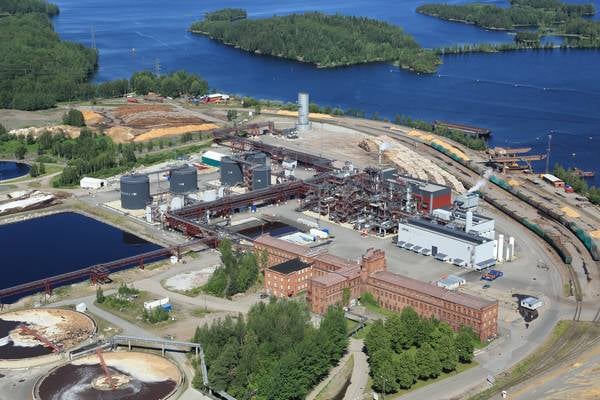
At its HVO plant, UPM Biofuels produces about 160 million liters of advanced biofuels and biomaterials annually based on tall oil. © UPM Biofuels
What about the availability of sustainable raw materials?
The limited availability of biomass tends to be used as justification to downplay the importance of low greenhouse gas biofuels. A new study from England entitled „Sustainable biomass availability in the EU to 2050“ paints a completely different picture. The study's authors conclude that up to 175 million tons of advanced and waste-based biofuels can be produced annually in Europe by 2050 - without harming biodiversity.
Even if parts of the biomass feedstock are used for the energy, industry, and household sectors, the share for transport in 2050 should be sufficient to produce up to 135 million tons of biofuels. Including biomass imports into the EU, production capacity could reach up to 175 million tons of biofuels.
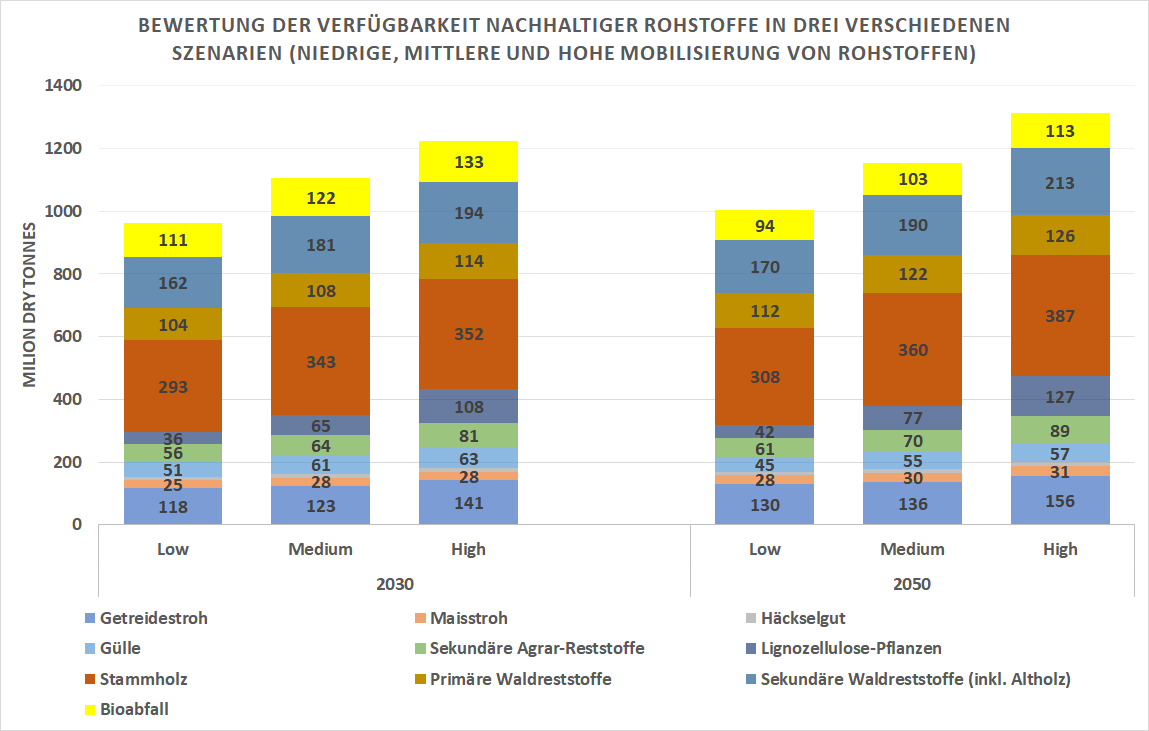
Source: FuelsEurope, Research „Sustainable biomass availability in the EU to 2050“
The assessment of the biomass potential is a result of very conservative assumptions. There is an additional potential of sustainable biomass feedstocks for renewable energies that have not been included in the calculations. Because, among other reasons, the raw materials have not yet been mentioned in the annexes of the Renewable Energy Directive (REDII). Therefore, the biomass potentials in the future could be significantly higher than estimated in the study.
In addition, low-carbon biofuels offer a "no-regret" option due to short- and long-term benefits:
- Scaling up production capacities will successively reduce the cost of biofuels.
- The internal combustion engine fleet can operate with low greenhouse gas emissions.
- Over time, the decline in demand for liquid fuels from road transport will enable a growing supply for aviation and marine transport at competitive prices.
Advanced and waste-based biofuels, together with other biofuels with a low iLUC iLUC-Risiko (indirect land-use change -Risk), can thus play a key role in decarbonizing EU transport in line with the 2050 climate neutrality target.
Conclusion: The future belongs to advanced biodiesel
Sustainably produced biodiesel is the most readily available option for switching to renewable energies in the transportation sector. However, the energy transition driven by EU targets cannot be achieved through electromobility alone. With the revision of the Renewable Energy Directive (RED II), the EU is setting the political framework for the increased use of waste and residual materials to produce biodiesel. In addition, the combination of high oil prices, public subsidies, and rising CO2 taxes is making sustainably produced biodiesel economical again.
Sources:
- „Sustainable biomass availability in the EU to 2050“, FuelsEurope
- Strategy Paper „Clean Fuels For All“
- Report 2020, Biokraft Austria
- SHORT-TERM OUTLOOK for EU agricultural markets in 2021
- RES in Transport barometer 2021, EurObserv’ER
- Report 2020, BMK
- Policy Brief: Biofuels for transport, Bioenergy Europe Statistical Report 2021
- 10 years of EU fuels policy increased EU’s reliance on unsustainable biofuels TRANSPORT & ENVIRONMENT





